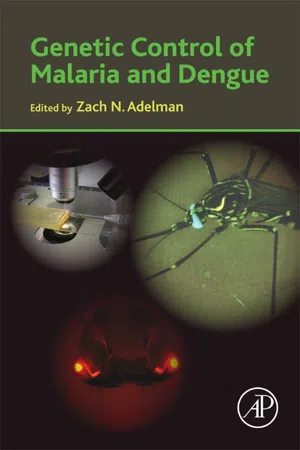
- 486 pages
- English
- ePUB (mobile friendly)
- Available on iOS & Android
Genetic Control of Malaria and Dengue
About this book
Genetic Control of Malaria and Dengue focuses on the knowledge, technology, regulation and ethics of using genetically modified mosquitoes to interrupt the transmission of important vector-borne diseases including Malaria. It contains coverage of the current state of knowledge of vector-borne diseases and how they are currently controlled; vaccine, drug and insecticide development; various strategies for altering the genome of mosquitoes in beneficial ways; and the regulatory, ethical and social environment concerning these strategies.For more than five decades, the prospect of using genetically-modified mosquitoes to control vector-borne disease transmission has been a purely hypothetical scenario. We simply did not have the technology or basic knowledge to be able to do it. With the explosion of field trials and potential interventions in development, Genetic Control of Malaria and Dengue provides a comprehensive overview of research in genetics, microbiology, virology, and ecology involved in the development and implementation of genetic modification programs for virus and disease control. This book is meant to provide a practical guide to researchers, regulators and the general public about how this technology actually works, how it can be improved, and what is still unknown.- Includes coverage of vectorial capacity, critical to understanding vector-borne disease transmission- Provides a summary of the concepts of both population suppression and population replacement- Contains pivotal coverage of ethical and ecological ramifications of genetics-based control strategies
Frequently asked questions
- Essential is ideal for learners and professionals who enjoy exploring a wide range of subjects. Access the Essential Library with 800,000+ trusted titles and best-sellers across business, personal growth, and the humanities. Includes unlimited reading time and Standard Read Aloud voice.
- Complete: Perfect for advanced learners and researchers needing full, unrestricted access. Unlock 1.4M+ books across hundreds of subjects, including academic and specialized titles. The Complete Plan also includes advanced features like Premium Read Aloud and Research Assistant.
Please note we cannot support devices running on iOS 13 and Android 7 or earlier. Learn more about using the app.
Information
Transgenic Pests and Human Health
A Short Overview of Social, Cultural, and Scientific Considerations*
Abstract
Keywords
Introduction
Current State of GMOs
Dengue Fever and Malaria
| Dengue | Malaria | |
| Vector | Aedes aegypti, Aedes albopictus (secondary) | About 20 species from the Anopheles genus |
| Strains | Four virus serotypes from the Flavivirus genus | Four parasite species from the Plasmodium genus |
| Severity | Contracting a second serotype results in a higher likelihood of experiencing severe dengue | Prevalence and severity varies with parasite (Plasmodium falciparum is the most common and deadly) |
| Immunity | Contracting one serotype provides permanent immunity to that strain and temporary immunity to the others | Partial immunity is accumulated over time and provides protection against severe disease |
| Diagnosis | ELISA tests for antigens (IgM & IgG), PCR | Rapid diagnostic tests for antigens, microscopy, PCR |
| Symptoms | Classic: fever, rash, headache, muscle aches, retro-orbital pain, vomiting | Classic: fever, headache, chills, vomiting |
| Severe: internal hemorrhaging, severe abdominal pain and vomiting, respiratory distress | Severe: anemia, respiratory distress, cerebral malaria, organ failure | |
| Mortality | Without treatment: about 20% mortality rate | About 627,000 deaths in 2012 |
| With treatment: less than 1% mortality rate | About 90% of deaths were from Africa, mostly among children | |
| Global burden | WHO [9]: 50–100 million cases per year | WHO [10]: about 207 (473–789) million cases in 2012 |
| Bhatt et al. [12]: about 390 million cases per year, including asymptomatic | ||
| Risk groups | Children, elderly, imunocompromised | Children, elderly, imunocompromised, tourists and immigrants |
| Vaccines | In development but not yet available | In development but not yet available |
| Treatment | Classic: fluids, pain medication, rest | Antimalarial medications (parasite resistance is a continuing issue) |
| Severe: fluid replacement therapy, blood transfusion | ||
| Common vector control | Container control, IRS of insecticides, larvicide packets in collected water | LLINs, indoor residual spraying of insecticides |
Dengue Fever
Table of contents
- Cover image
- Title page
- Table of Contents
- Copyright
- List of Contributors
- Biography
- Chapter 1. Transgenic Pests and Human Health: A Short Overview of Social, Cultural, and Scientific Considerations
- Chapter 2. Concept and History of Genetic Control
- Chapter 3. Considerations for Disrupting Malaria Transmission in Africa Using Genetically Modified Mosquitoes, Ecology of Anopheline Disease Vectors, and Current Methods of Control
- Chapter 4. Ecology of Malaria Vectors and Current (Nongenetic) Methods of Control in the Asia Region
- Chapter 5. Ecology of Anopheles darlingi, the Primary Malaria Vector in the Americas and Current Nongenetic Methods of Vector Control
- Chapter 6. Considerations for Disrupting Dengue Virus Transmission; Ecology of Aedes aegypti and Current (Nongenetic) Methods of Control
- Chapter 7. The Challenge of Disrupting Vectorial Capacity
- Chapter 8. Gene Insertion and Deletion in Mosquitoes
- Chapter 9. Gene Drive Strategies for Population Replacement
- Chapter 10. Exploring the Sex-Determination Pathway for Control of Mosquito-Borne Infectious Diseases
- Chapter 11. Disruption of Mosquito Olfaction
- Chapter 12. Disruption of Mosquito Blood Meal Protein Metabolism
- Chapter 13. Engineering Pathogen Resistance in Mosquitoes
- Chapter 14. Genetic Control of Malaria and Dengue Using Wolbachia
- Chapter 15. Employing the Mosquito Microflora for Disease Control
- Chapter 16. Regulation of Transgenic Mosquitoes
- Chapter 17. Economic Analysis of Genetically Modified Mosquito Strategies
- Chapter 18. Community Engagement
- Chapter 19. Impact of Genetic Modification of Vector Populations on the Malaria Eradication Agenda
- Index
